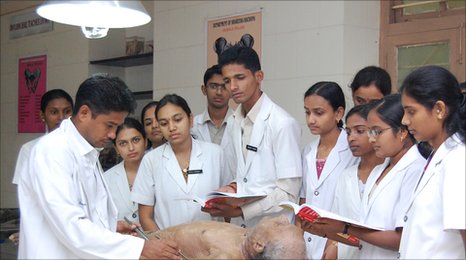High MBBS Fees leaves many doctors in debt trap
 Image: Healthcare India
Image: Healthcare India
In India, where there are only 60,000 MBBS seats, those who just qualified the NEET exam, and ranked 4 lakh also gets admission for MBBS. But how? With all colleges having to go by the NEET ranking in admission, the high fees charged by most private colleges make it possible. For Instance, take the case of admissions in Punjab. Eight of the medical colleges in Punjab are under the Baba Farid University of Health Sciences, three are government-run, four private ones, and a private university. The student with the highest NEET marks among those admitted into the private university had lower marks than the last students admitted to the open category in each of the government colleges. But while the fees in the government colleges are 4 lakhs, private colleges charge up to 64 lakhs for completing the course. Even the candidates who got into the government quota of private colleges had the best scores, private universities saw candidates with much lower scores getting the admissions by paying high fees.

High fees in some medical colleges mean that the students who have to take loans to pay it cannot hope to repay the loans by their earnings as a doctor.
The average annual tuition fees in private medical colleges are over Rs 10 lakh. That is just the half of the total fees, which might be near a crore or more including the hostel fees and other expenses. If one takes an educational loan of 50 lakh, its EMI works out to be at least Rs 60,000. Government salaries for an MBBS graduate range from Rs 45,000 to 65000 according to the area and state. When comes to the private sector, it is even worse.
But the government is allowing the opening of more private colleges and increasing the seats in existing ones to cite the problem with the shortage of doctors. In most banks, education loans cannot exceed Rs 7 lakh to Rs. 10 lakh without collateral, which typically would mean mortgaging a house or land.
Such educational loan usually carries an interest of 10-12.5% which has to be paid within a period of 10-12 years. An analysis by Times of India, on the fees charged in 210 private medical colleges in 2017 show that about 50 charged anything between Rs 10 lakh and Rs 15 lakh and over 30 charged even more. Several government colleges too charge high fees, especially in Gujarat and Rajasthan. After 4.5 years of MBBS, a student has to do a one-year paid internship during which that student’s salary would be 20000 to 25000. After MBBS, whether a student is doing post-graduation or working as a resident doctor or medical officer, the salary in the government sector usually ranges between 40000 to 55000 in most states. After an experience of 3-4 years, the salary rises to about Rs 70,000 at best in most places. But with EMIs of Rs 45,000- 65,000 for loans ranging from Rs. 30 lakh to Rs 50 lakh, doctors are left with barely enough to live on.
To sum up, what all these data mean is that, the Medical education in India is becoming a debt trap for the students. Even the medical colleges in the states with fee regulation charge around, Rs. 2.5 to over 6 lakh, which opens a trap of debt.